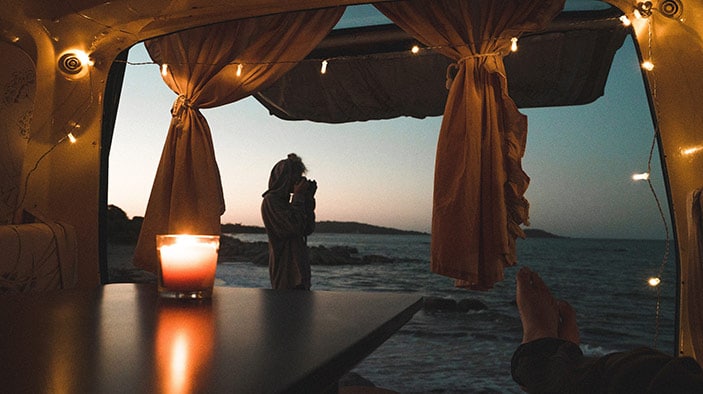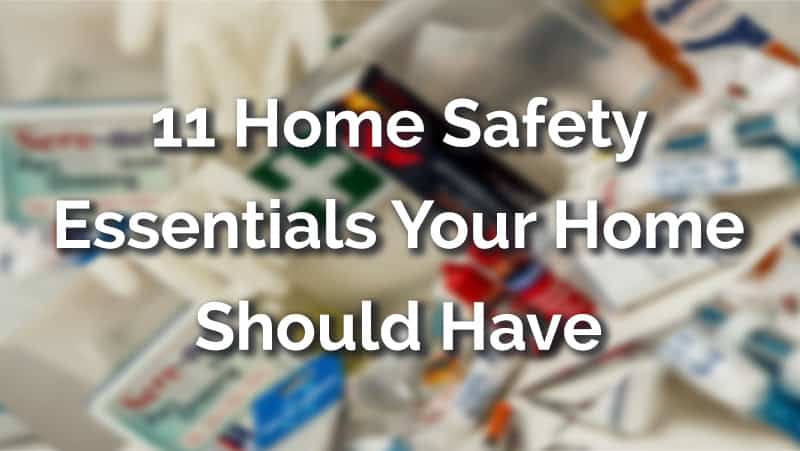Home accidents happen. You probably won’t be able to prevent all of them but if you take home safety seriously, you can reduce their number to a bare minimum. The fact that you’re on this page reading this post means you’re well ahead of others who simply don’t care about improving safety until an accident happens.
In this article, we’ve collected some of the most important home safety essentials that will help you prevent injuries and accidents. Many of them can potentially save your life one day.
So, without further ado, here are the most important home safety essentials you should have:
- Fire extinguisher
- Carbon monoxide alarms
- Smoke alarms
- Fire escape plan
- Emergency phone numbers
- Flameless candles
- Fire escape ladder
- First aid kit
- Grade 1 deadbolt
- A safe place for your valuables
- Portable power station or generator
Keep reading for the details and more useful tips:
Home Safety Essentials That Can Potentially Save Your Life
1. Fire Extinguishers: The More, the Better

Fire extinguishers are one of the most basic safety items that you should have in your home no matter where you live.
Fortunately, many people have a fire extinguisher in their house or apartment, however, in most cases, you need more than one. It’s especially true if you live in a two-story house. Imagine there’s a fire on the second floor and you have to go downstairs for the fire extinguisher. You lose valuable time. And speed is extremely important when it comes to home fires: they can be life-threatening within only a few minutes. Just check out the video below to have an idea.
Most homes should have at least two or three fire extinguishers. All of them should be easily accessible in case of a fire. Make sure you keep one close to the entrance of the kitchen where most home fires occur. Also, it’s recommended to have one in the main hallway and close to an exit. Multi-level houses should have at least one fire extinguisher on each floor.
The National Fire Protection Association (NFPA) recommends choosing multi-purpose (ABC) fire extinguishers for your home. These can be used on all types of home fires. We have an illustrated guide on the different types of fire extinguishers that you can find here.
Remember: a fire extinguisher can be a real lifesaver but only if you know how to use it. Make sure you read the instructions after purchasing so you won’t have to waste your time figuring things out in case of an emergency.
2. Carbon Monoxide (CO) Alarms
If you have any fuel-burning appliance, a fireplace, or a garage attached to your house, you should definitely install CO alarms.
Carbon monoxide is an odorless, colorless, and tasteless gas, so it can’t be detected without using a CO detector. If it accumulates inside your home, it can cause serious, even life-threatening health issues. All it takes is one faulty fuel-burning appliance or inappropriate ventilation for this to happen.
Therefore, CO alarms should be installed in every bedroom and each room where there’s a fuel-burning appliance (check out our illustrated guide to CO detector placement here). CO alarms are usually powered by batteries and should be tested at regular intervals to make sure they work properly. If the alarm sounds, you should immediately look for the nearest exit and leave your home. Then call 911 or the local fire department.
3. Smoke Alarms: Must-Have Safety Items for Your Home
When it comes to home safety essentials, smoke alarms and fire extinguishers are a must. Most houses and apartments have either standalone smoke alarms or smoke detectors connected to a fire alarm system. If your home is an exception, you should invest a few bucks in safety as soon as you can.
Home fires often remain unnoticed until they become hardly manageable. Many fires occur at night when the residents are sleeping. A fire alarm will alert you immediately if it detects a fire, so you will have enough time to prevent it from spreading. When it comes to home fires, quick action can be the difference between life and death.
4. Fire Escape Plan
Every home should have a fire escape plan. Yours too. Creating one is neither difficult nor time-consuming and it’s well worth the effort.
Make sure each room has at least two exits and specify them in your plan. Also, check if the doors and windows can be opened without any difficulty. Remove obstacles from the escape routes. Don’t forget to share the escape plan with your family members. You can find more details about creating a home fire escape plan here.
5. Emergency Phone Numbers
Place a list with the most important emergency numbers in a clearly visible place in your home so that every family member knows what number to dial in case of an emergency. This step is especially important if there are children or seniors in your family.
Include these numbers on the list:
- Nationwide emergency number (911 in the U.S., 999 or 112 in the U.K., 000 in Australia)
- Local fire and police department
- Poison control center
- Local hospital
- Doctor
- Insurance company
- Friends, neighbors, co-workers, and family members who you can call when you need help
- Locksmith
- Power and water company
- Pharmacy
6. Flameless Candles

Don’t get me wrong, I don’t think you should never use traditional candles. Sometimes all you need is a few candles to make a room cozy and feel more intimate. However, you should know that unattended candles cause many home fires every year.
So, if you light a candle, do not leave it unattended (never sleep with a burning candle in the room). Also, make sure there’s nothing flammable (like curtains) around it. If you leave the room, always extinguish the candle.
If you use candles frequently, consider buying some flameless ones. This way you can considerably reduce the risk of a fire.
7. Fire Escape Ladder
If you live in a multi-level home, you can’t really use your windows as an exit. That’s a huge problem because in case of a fire you can easily be cornered. Installing fire escape rope ladders is a safe and unobtrusive way to turn your windows into real emergency exits.
While it’s true that a fire escape ladder is not the cheapest home safety item, it’s well worth the investment because it can not only give you peace of mind but also save your life.
8. First Aid Kit

A first aid kit is an essential item when it comes to home safety. Minor injuries can often be treated at home if you have first aid supplies at hand.
You can buy a ready-to-use first aid kit at the local pharmacy or online as well, and then you can add more items to it according to your needs. For instance, if you’re allergic to food or insect stings, you should have injectable epinephrine (like EpiPen or Auvi-Q) at home. It can save your life.
American Family Safety, a leading provider of emergency supplies, has some really great home safety kits that include all the essential stuff.
A home first aid kit should include the following items:
- Adhesive bandages
- Triangular bandages
- Gauze rolls
- Gauze sponge
- Medical tape
- CPR face mask
- Alcohol-free cleansing wipes
- Scissors
- Tweezers
- Painkillers
- Antihistamine tablets
- Anesthetic spray for itching insect bites
- Disposable sterile gloves
- First aid guide (you can use an app instead)
- Injectable epinephrine, if necessary
Other Essential Home Safety Items
9. Grade 1 Deadbolt
Burglars almost always prefer easy targets. If you secure your doors and windows, crooks will see that you take home security seriously and chances are great that they’ll look for another target.
If you want to prevent break-ins, you should start by reinforcing your front door. There are many ways you can do it, however, it’s essential to have a reliable and durable deadbolt. Unfortunately, many front doors are equipped with a rather poor-quality deadbolt that an average burglar can open within only a few seconds.
A BHMA/ANSI Grade 1 deadbolt provides the highest level of security. It’s not only extremely durable and reliable but also serves as a great burglar deterrent. Kwikset has some really good quality Grade 1 deadbolts, like the 980 series. If you want to secure your front door, I definitely recommend you start by installing a Grade 1 deadbolt. It’s a worthy investment.
10. A Safe or a Hidden Place for Your Valuables
Your primary goal should always be to prevent burglaries, that’s why it’s so important to reinforce your doors and windows. However, if despite all of your efforts burglars manage to break into your home, you can make them leave without your most valuable items by hiding them in a secret place.
In most cases having a safe in itself is not enough to protect your valuables. You also have to conceal it so that intruders won’t be aware of its existence. We’ve collected the best secret places to hide your safe here.
It’s not always necessary to use a safe to hide your most valuable items. You can find many uncommon hiding spots in your home that burglars won’t find during their stay. For instance, you can use an empty paint can, a false-bottom drawer, or a soccer ball, but you can also bury your money and other valuables in unused kitty litter.
11. Portable Power Station/Generator
If natural disasters are not uncommon in your region, you should always keep a disaster kit at home. This should include all the basic supplies that you and your family need to survive (non-perishable food, water, cash, blankets, flashlight, medications, etc.).
A portable power station or a generator can be extremely useful in case of a natural disaster, however, you can benefit from them in many other situations as well (like camping, fishing, or other outdoor activities).
The major advantage of power stations over gas generators is that you can use them inside your home because they don’t generate any emissions. On the other hand, generators deliver more power than power stations. So, you should choose according to your needs. I strongly recommend you include either a portable power station or a generator in your disaster kit, especially if you have kids.
If you want to know more about how you can make your home a safer place, here you’ll find a detailed article with more than 70 home safety measures and tips we’ve collected for you.











